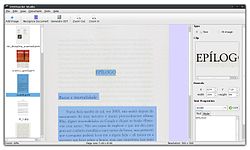- OCRFeeder
-
OCRFeeder 

Developer(s) Joaquim Rocha (Igalia) Stable release 0.7.6 / August 5, 2011[1] Development status Active Written in Python Platform Linux Available in Interface: Czech, Danish, German, English, Spanish, French, Galician, Italian, Norwegian (bokmål), Portuguese, Romanian, Slovenian, Swedish, Chinese[2]
Recognition: depends on OCR engine usedType Optical character recognition License GPL (free software) Website live.gnome.org/OCRFeeder OCRFeeder is a free software desktop OCR suite for GNOME. It converts paper documents to digital document files or makes them accessible to visually impaired users.
OCRFeeder is distributed as free software under GNU General Public License (GPL) version 3 or later. It is available for Unix-like operating systems, either in source code or as pre-built binary package for systems that are based on the Debian package management system or third-party builds for openSUSE[3] and Slackware. In Debian-based Linux distributions it may be installed directly from the default software channels.[4]
Contents
History
OCRFeeder was started as a master's thesis in computer science by Joaquim Rocha,[5] who is now working for Igalia, S.L. and continuing development there.[6]
The first version was published in March 2009.[7] The OCRFeeder project was initially published and hosted on Google Code, temporarily used Gitorious[8] and now uses the GNOME infrastructure.[9] Since 5 April 2010 a software package is included in the official Debian repositories.[10]
Version 0.7 from July 30, 2010 brought image pre-processing features, 0.7.1 (November 8, 2010) enabled for scanner access from within OCRFeeder.
Features
OCRFeeder has a simple graphical user interface that is designed to the GNOME Human Interface Guidelines. It performs a Document Layout Analysis and transfers the layout to capable output formats. It searches for content areas, outlines them and guesses the content type (text or image) and processes text areas through the OCR backend. It can use virtually any commandline OCR engine as backend and features auto-detection and auto-configuration for all popular free engines. OCR backends may be either auto-configured, the necessary command line entered in a GUI dialogue or configured directly via a XML file. Scan image post-processing including deskewing can be done.[11] All recognition results can be reviewed and edited before saving to the desired output format. Sessions can be saved and loaded. The suite also includes a spell checker.[12] OCRFeeder has built-in procedures for the post-processing of the raw OCR results returned by the OCR engine. It can remove remaining segmentation to printed lines of text, even with removal of hyphenation.
Although OCRFeeder is a GUI tool, it can also run in command line mode (as ocrfeeder-cli), which may be a useful tool for automatic document batch processing.[13] In this mode OCRFeeder uses the default OCR engine, which the user can set in the application's preferences.[14][15]
The program is written in Python and uses the GTK+ library (using PyGTK).[13] It acts as a graphical front-end for other existing tools. For example it does not make actual character recognition itself, but uses external programs such as an “OCR engine” that is installed on the system. It can automatically detect and configure CuneiForm, GOCR, Ocrad and Tesseract as backend OCR engines.[16] Scanners are accessed via SANE. For post-processing of scanned images there is integration of the command-line tool “Unpaper”,[13] among other things. PDF files are processed using Ghostscript in the backend.
Input and output
OCRFeeder can import data from PDF or graphic files. From 0.7.1a version it supports grabbing images directly from the scanner device.[12]
The results can be saved in HTML, OpenDocument or plain text[17] file formats (initial formatting can be done directly in the program). hOCR file output is also planned.[5]
References
- ^ Rocha, Joaquim (2011-08-05). "OCRFeeder 0.7.6 and DesktopSummit 2011". http://www.joaquimrocha.com/2011/08/05/ocrfeeder-0-7-6-and-desktopsummit-2011/. Retrieved 2011-10-30.
- ^ "GNOME GIT source code repository, LINGUAS file". http://git.gnome.org/browse/ocrfeeder/tree/po/LINGUAS. Retrieved 2011-02-09.
- ^ OpenSUSE - ocrfeeder
- ^ Package ocrfeeder, Canonical Ltd, 2011
- ^ a b "OCRFeeder - GNOME Live!". http://live.gnome.org/OCRFeeder. Retrieved 2011-02-09.
- ^ Igalia - OCRFeeder
- ^ OCRFeeder, Google Code
- ^ live.gnome.org Differences between revisions 2 and 3
- ^ live.gnome.org - Differences between revisions 5 and 6
- ^ Debian Changelog ocrfeeder (0.6.6+dfsg1-1)
- ^ "GNOME GIT source code repository, NEWS file". http://git.gnome.org/browse/ocrfeeder/tree/NEWS. Retrieved 2011-02-03.
- ^ a b Rocha, Joaquim (2010-11-09). "OCRFeeder version 0.7.1a released". http://www.joaquimrocha.com/2010/11/09/ocrfeeder-version-0-7-1a-released/. Retrieved 2011-02-09.
- ^ a b c "GNOME GIT source code repository, README file". http://git.gnome.org/browse/ocrfeeder/tree/README. Retrieved 2011-02-09.
- ^ Μάνος (2011-03-22). "OCRFeeder 0.7.4: Ψηφιοποιήστε τα έγγραφα σας". OSArena. http://osarena.net/2011/03/ocrfeeder-0-7-4-psifiopiiste-ta-engrafa-sas.html. Retrieved 2011-06-08.
- ^ Hejda, Václav (2011-05-26). "OCRFeeder – Užitečný rozpoznávač textu, který však neumí česky". LinuxEXPRES.cz. QCM s.r.o.. http://www.linuxexpres.cz/software/ocrfeeder-uzitecny-rozpoznavac-textu-ktery-vsak-neumi-cesky. Retrieved 2011-06-08.
- ^ "GNOME GIT source code repository, configuration.py file". http://git.gnome.org/browse/ocrfeeder/tree/src/ocrfeeder/studio/configuration.py. Retrieved 2011-02-03.
- ^ OCRFeeder Version 0.7.4 New Features
External links
Optical character recognition software Free software Proprietary software ExperVision · FineReader · Microsoft Office Document Imaging · OmniPage · Readiris · ReadSoft · SimpleOCR · SmartScore · VueScanSee also Categories:- Optical character recognition
- Free software programmed in Python
Wikimedia Foundation. 2010.
